2023 TOYOTA PRIUS PLUG-IN HYBRID inflation pressure
[x] Cancel search: inflation pressurePage 613 of 818
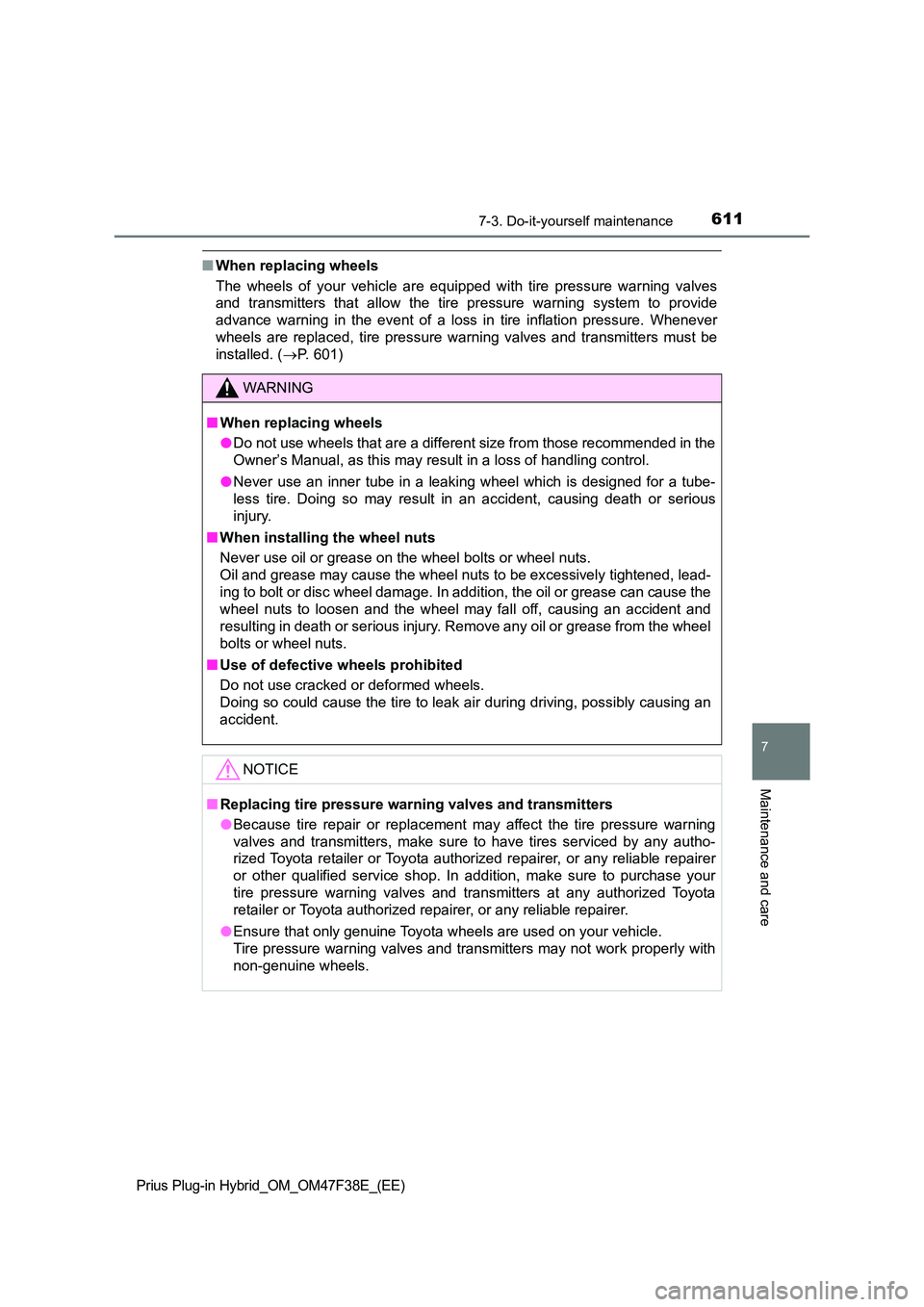
6117-3. Do-it-yourself maintenance
Prius Plug-in Hybrid_OM_OM47F38E_(EE)
7
Maintenance and care
■When replacing wheels
The wheels of your vehicle are equipped with tire pressure warning valves
and transmitters that allow the tire pressure warning system to provide
advance warning in the event of a loss in tire inflation pressure. Whenever
wheels are replaced, tire pressure warning valves and transmitters must be
installed. ( P. 601)
WARNING
■When replacing wheels
● Do not use wheels that are a different size from those recommended in the
Owner’s Manual, as this may result in a loss of handling control.
● Never use an inner tube in a leaking wheel which is designed for a tube-
less tire. Doing so may result in an accident, causing death or serious
injury.
■ When installing the wheel nuts
Never use oil or grease on the wheel bolts or wheel nuts.
Oil and grease may cause the wheel nuts to be excessively tightened, lead-
ing to bolt or disc wheel damage. In addition, the oil or grease can cause the
wheel nuts to loosen and the wheel may fall off, causing an accident and
resulting in death or serious injury. Remove any oil or grease from the wheel
bolts or wheel nuts.
■ Use of defective wheels prohibited
Do not use cracked or deformed wheels.
Doing so could cause the tire to leak air during driving, possibly causing an
accident.
NOTICE
■ Replacing tire pressure warning valves and transmitters
● Because tire repair or replacement may affect the tire pressure warning
valves and transmitters, make sure to have tires serviced by any autho-
rized Toyota retailer or Toyota authorized repairer, or any reliable repairer
or other qualified service shop. In addition, make sure to purchase your
tire pressure warning valves and transmitters at any authorized Toyota
retailer or Toyota authorized repairer, or any reliable repairer.
● Ensure that only genuine Toyota wheels are used on your vehicle.
Tire pressure warning valves and transmitters may not work properly with
non-genuine wheels.
Page 665 of 818

6638-2. Steps to take in an emergency
Prius Plug-in Hybrid_OM_OM47F38E_(EE)
8
When trouble arises
Tire pressure warning light
When the light comes on:
Low tire inflation pressure such as
• Natural causes ( P. 665)
• Flat tire ( P. 675)
Adjust the tire inflation pressure to the specified
level.
The light will turn off after a few minutes. In case the
light does not turn off even if the tire inflation pres-
sure is adjusted, have the system checked by any
authorized Toyota retailer or Toyota authorized
repairer, or any reliable repairer.
When the light comes on after blinking for 1 minute:
Malfunction in the tire pressure warning system ( P. 665)
Have the system checked by any authorized Toyota
retailer or Toyota authorized repairer, or any reliable
repairer.
Inappropriate pedal operation warning light*6 (warning
buzzer)
When a buzzer sounds:
Indicates a malfunction in:
• The Brake Override System
• The Drive-Start Control
Have the vehicle inspected by any authorized Toyota
retailer or Toyota authorized repairer, or any reliable
repairer.
Indicates that the shift position was changed and Drive-
Start Control was operated while depressing the accelera-
tor pedal.
Momentarily release the accelerator pedal.
Indicates that the Parking Support Brake function (if
equipped) is operating ( P. 468)
Follow the instruction that is displayed on the multi-
information display.
When a buzzer does not sound:
Indicates that the accelerator and brake pedals are being
depressed simultaneously, and the Brake Override Sys-
tem is operating.
Release the accelerator pedal and depress the brake
pedal.
Warning lightWarning light/Details/Actions
Page 667 of 818
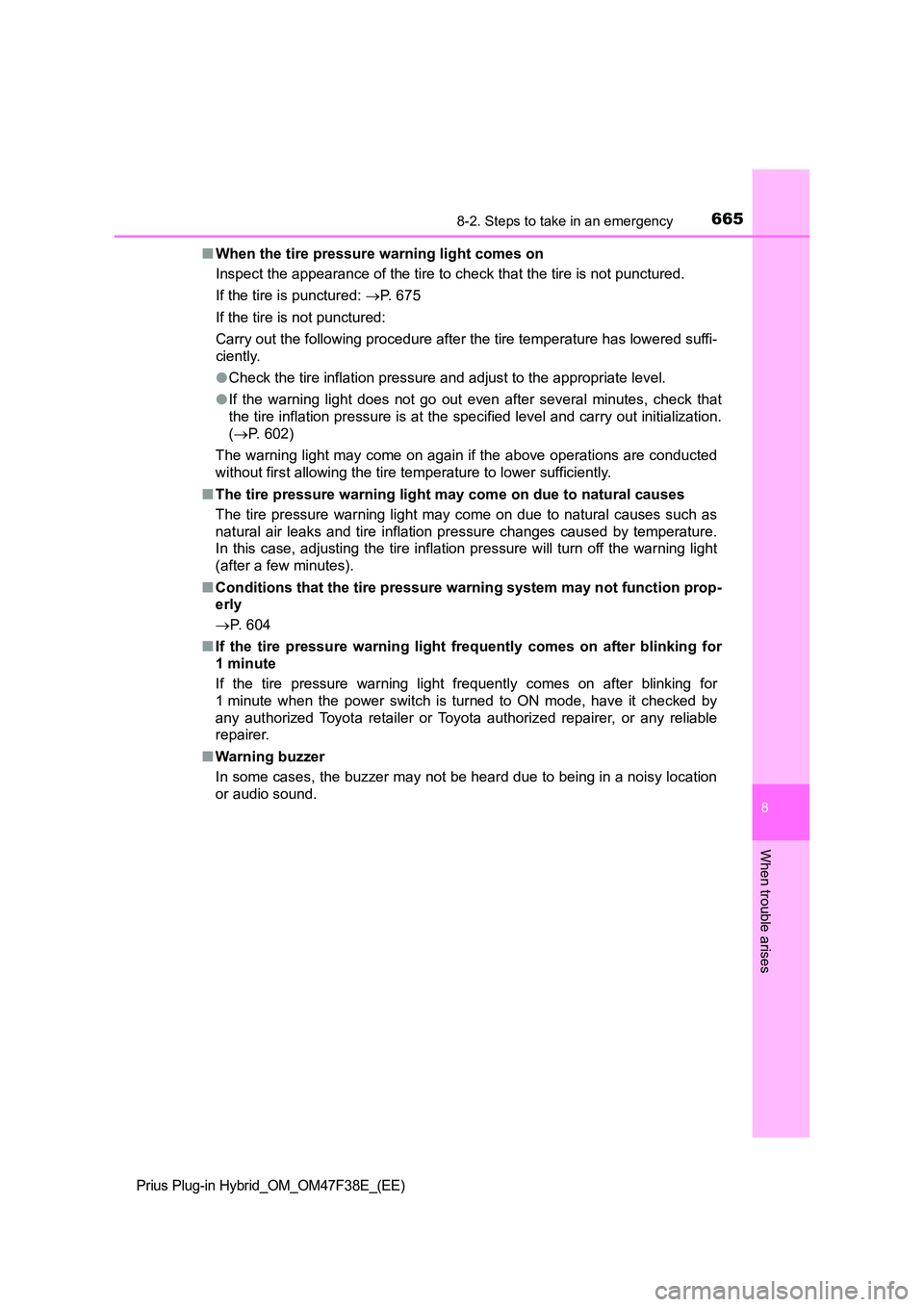
6658-2. Steps to take in an emergency
Prius Plug-in Hybrid_OM_OM47F38E_(EE)
8
When trouble arises
■When the tire pressure warning light comes on
Inspect the appearance of the tire to check that the tire is not punctured.
If the tire is punctured: P. 675
If the tire is not punctured:
Carry out the following procedure after the tire temperature has lowered suffi-
ciently.
● Check the tire inflation pressure and adjust to the appropriate level.
● If the warning light does not go out even after several minutes, check that
the tire inflation pressure is at the specified level and carry out initialization.
( P. 602)
The warning light may come on again if the above operations are conducted
without first allowing the tire temperature to lower sufficiently.
■ The tire pressure warning light may come on due to natural causes
The tire pressure warning light may come on due to natural causes such as
natural air leaks and tire inflation pressure changes caused by temperature.
In this case, adjusting the tire inflation pressure will turn off the warning light
(after a few minutes).
■ Conditions that the tire pressure warning system may not function prop-
erly
P. 604
■ If the tire pressure warning light frequently comes on after blinking for
1minute
If the tire pressure warning light frequently comes on after blinking for
1 minute when the power switch is turned to ON mode, have it checked by
any authorized Toyota retailer or Toyota authorized repairer, or any reliable
repairer.
■ Warning buzzer
In some cases, the buzzer may not be heard due to being in a noisy location
or audio sound.
Page 668 of 818

6668-2. Steps to take in an emergency
Prius Plug-in Hybrid_OM_OM47F38E_(EE)
WARNING
■When the electric power steering system warning light comes on
When the light comes on yellow, the assist to the power steering is
restricted. When the light comes on red, the assist to the power steering is
lost and handling operations of the steering wheel become extremely
heavy. When steering wheel operations are heavier than usual, grip the
steering wheel firmly and operate it using more force than usual.
■ If the tire pressure warning light comes on
Be sure to observe the following precautions. Failure to do so could cause a
loss of vehicle control and result in death or serious injury.
● Stop your vehicle in a safe place as soon as possible. Adjust the tire infla-
tion pressure immediately.
● If the tire pressure warning light comes on even after tire inflation pressure
adjustment, it is probable that you have a flat tire. Check the tires. If a tire
is flat, repair the flat tire by us ing emergency tire puncture repair kit.
● Avoid abrupt maneuvering and braking. If the vehicle tires deteriorate, you
could lose control of the steering wheel or the brakes.
■ If a blowout or sudden air leakage should occur
The tire pressure warning system may not activate immediately.
NOTICE
■ To ensure the tire pressure warning system operates properly
Do not install tires with different specif ications or makers, as the tire pres-
sure warning system may not operate properly.
Page 685 of 818
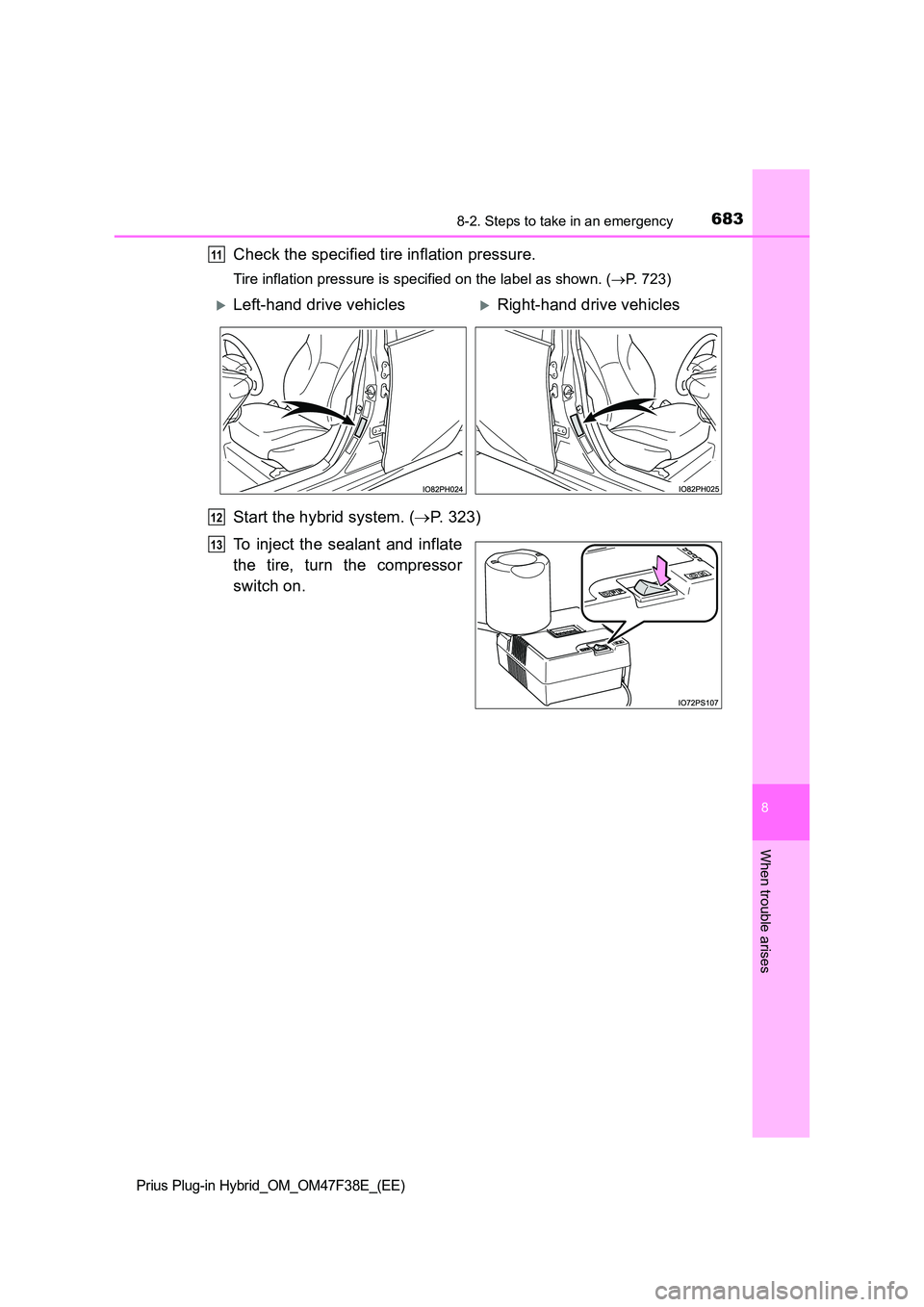
6838-2. Steps to take in an emergency
Prius Plug-in Hybrid_OM_OM47F38E_(EE)
8
When trouble arises
Check the specified tire inflation pressure.
Tire inflation pressure is specified on the label as shown. (P. 723)
Start the hybrid system. (P. 323)
To inject the sealant and inflate
the tire, turn the compressor
switch on.
11
Left-hand drive vehiclesRight-hand drive vehicles
12
13
Page 686 of 818

6848-2. Steps to take in an emergency
Prius Plug-in Hybrid_OM_OM47F38E_(EE)
Inflate the tire until the specified air pressure is reached.
The sealant will be injected
and the pressure will spike to
300 kPa (3.0 kgf/cm2 or bar, 44
psi) or 400 kPa (4.0 kgf/cm2 or
bar, 58 psi), then gradually
decrease.
The air pressure gauge will
display the actual tire infla-
tion pressure about 1 to 5
minutes after the switch is
turned on.
Turn the compressor switch off
and then check the tire inflation
pressure.
Being careful not to over inflate,
check and repeat the inflation
procedure until the specified tire
inflation pressure is reached.
The tire can be inflated for about 5 to 20 minutes (depending on the out-
side temperature). If the tire inflation pressure is still lower than the
specified point after inflation for 25 minutes, the tire is too damaged to
be repaired. Turn the compressor switch off and contact any authorized
Toyota retailer or Toyota authorized repairer, or any reliable repairer.
If the tire inflation pressure exceeds the specified air pressure, let out
some air to adjust the tire inflation pressure. ( P. 687, 723)
With the compressor switch off, pull out the power plug from the
power outlet socket and then disconnect the hose from the valve on
the tire.
Some sealant may leak when the hose is removed.
Install the valve cap onto the valve of the emergency repaired tire.
Attach the air release cap to the
end of the hose.
If the air release cap is not
attached, the sealant may leak and
the vehicle may get dirty.
14
1
2
15
16
17
Page 687 of 818
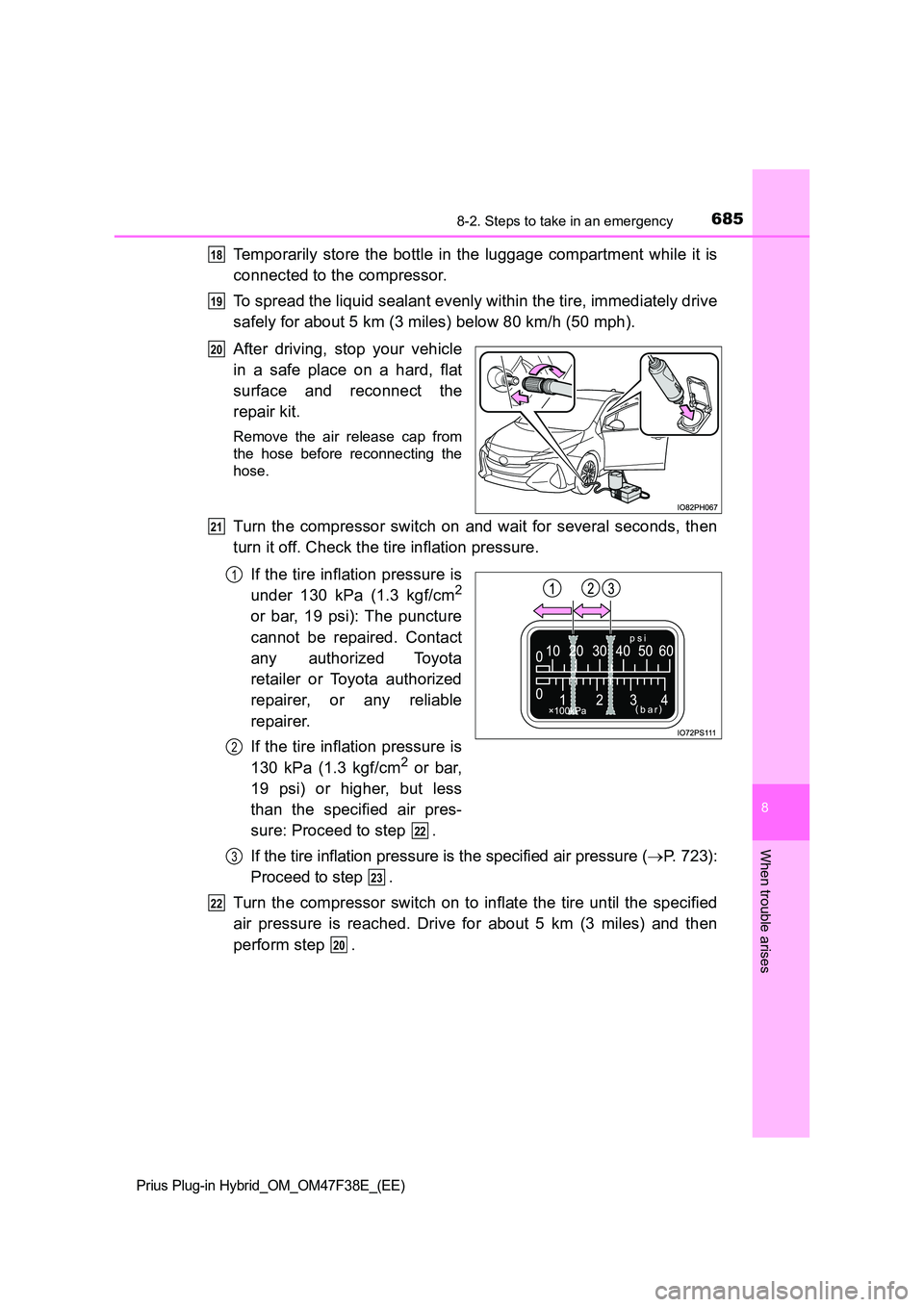
6858-2. Steps to take in an emergency
Prius Plug-in Hybrid_OM_OM47F38E_(EE)
8
When trouble arises
Temporarily store the bottle in the luggage compartment while it is
connected to the compressor.
To spread the liquid sealant evenly within the tire, immediately drive
safely for about 5 km (3 miles) below 80 km/h (50 mph).
After driving, stop your vehicle
in a safe place on a hard, flat
surface and reconnect the
repair kit.
Remove the air release cap from
the hose before reconnecting the
hose.
Turn the compressor switch on and wait for several seconds, then
turn it off. Check the tire inflation pressure.
If the tire inflation pressure is
under 130 kPa (1.3 kgf/cm2
or bar, 19 psi): The puncture
cannot be repaired. Contact
any authorized Toyota
retailer or Toyota authorized
repairer, or any reliable
repairer.
If the tire inflation pressure is
130 kPa (1.3 kgf/cm2 or bar,
19 psi) or higher, but less
than the specified air pres-
sure: Proceed to step .
If the tire inflation pressure is the specified air pressure ( P. 723):
Proceed to step .
Turn the compressor switch on to inflate the tire until the specified
air pressure is reached. Drive for about 5 km (3 miles) and then
perform step .
18
19
20
21
1
2
22
3
23
22
20
Page 689 of 818
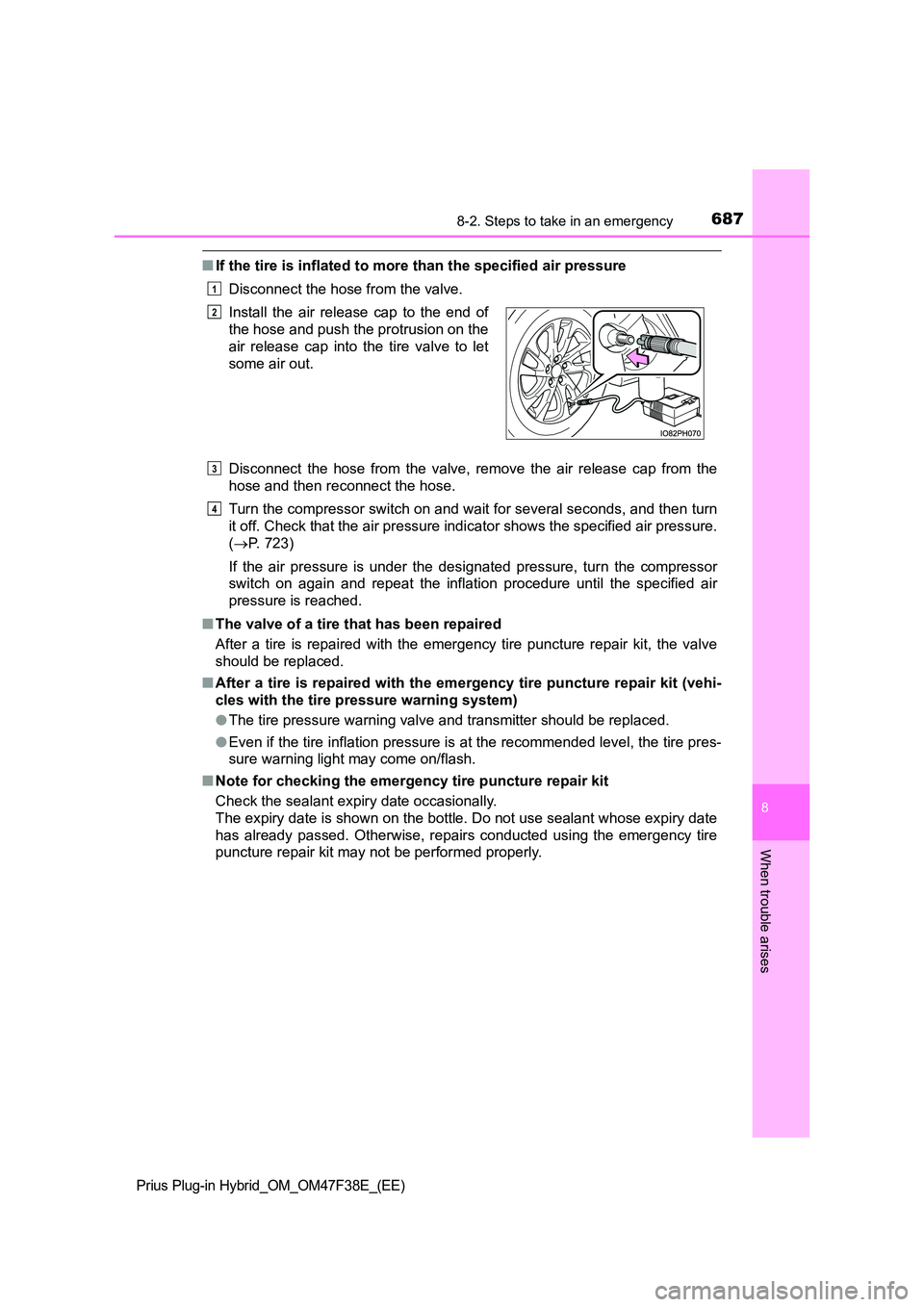
6878-2. Steps to take in an emergency
Prius Plug-in Hybrid_OM_OM47F38E_(EE)
8
When trouble arises
■If the tire is inflated to more than the specified air pressure
Disconnect the hose from the valve.
Disconnect the hose from the valve, remove the air release cap from the
hose and then reconnect the hose.
Turn the compressor switch on and wait for several seconds, and then turn
it off. Check that the air pressure indicator shows the specified air pressure.
( P. 723)
If the air pressure is under the designated pressure, turn the compressor
switch on again and repeat the inflation procedure until the specified air
pressure is reached.
■ The valve of a tire that has been repaired
After a tire is repaired with the emer gency tire puncture repair kit, the valve
should be replaced.
■ After a tire is repaired with the emergency tire puncture repair kit (vehi-
cles with the tire pressure warning system)
● The tire pressure warning valve and transmitter should be replaced.
● Even if the tire inflation pressure is at the recommended level, the tire pres-
sure warning light may come on/flash.
■ Note for checking the emergency tire puncture repair kit
Check the sealant expiry date occasionally.
The expiry date is shown on the bottle. Do not use sealant whose expiry date
has already passed. Otherwise, repairs conducted using the emergency tire
puncture repair kit may not be performed properly.
Install the air release cap to the end of
the hose and push the protrusion on the
air release cap into the tire valve to let
some air out.
1
2
3
4